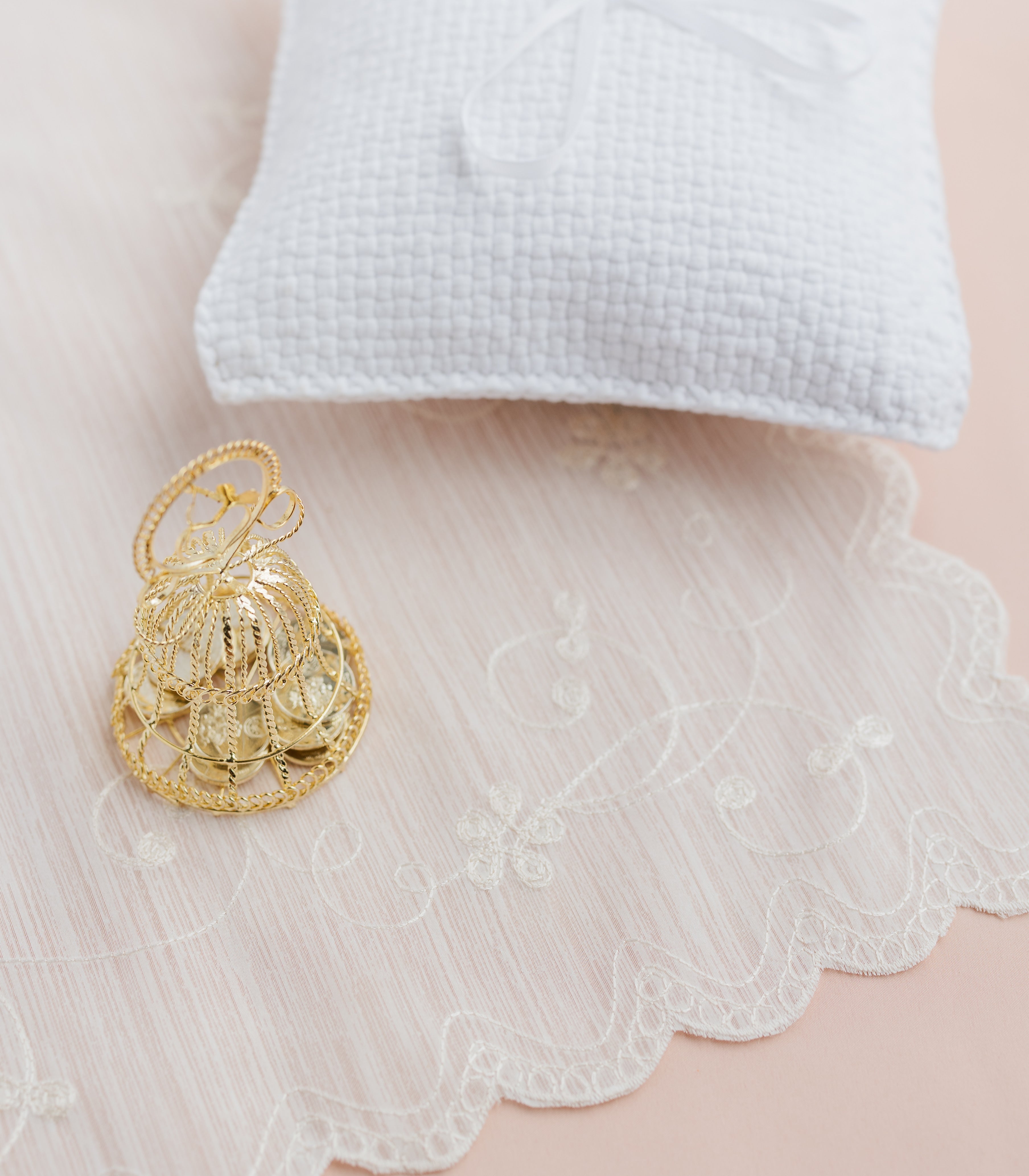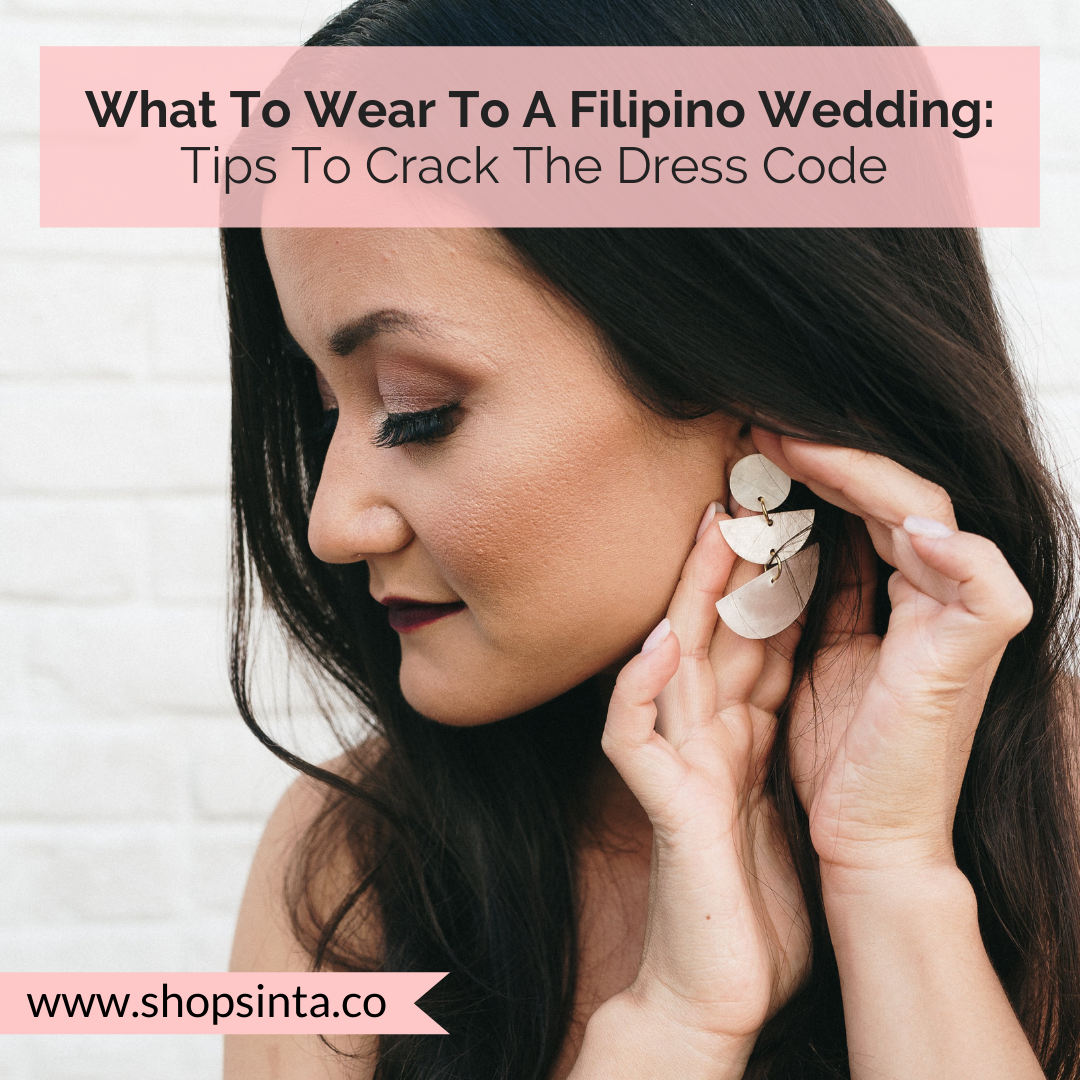When attending a Filipino wedding, or planning your own, one of the biggest questions is always the dress code. What exactly should you wear? As more couples are inspired to celebrate their Filipino heritage on their special day, guests might feel the added pressure to participate. Should you start finding traditional Filipiniana right away, or would it be perfectly fine to show up in modern formalwear?
The answer, as with any special occasion, is it depends. A wedding is always as unique as the couple it celebrates.
Nowadays, there’s a spectrum of styles one can expect as the couple and entourage walk down the aisle: billowing white dresses, regal ternos, or Barong Tagalogs with a trendy twist!
There’s even more ways to celebrate Filipino culture with some smart accessorizing. Ace the dress code at the next Filipino wedding with these style tips!
For The Groom: Dashing Barong Tagalog or Dapper Amerikana
 A groom in a Chinese-collared Barong Tagalog. (Source: Kasal.com)
A groom in a Chinese-collared Barong Tagalog. (Source: Kasal.com)

Filipino celebrities in modern Barong Tagalogs at the ABS-CBN Ball, an event by one of the country’s leading TV networks. (Source: Metro.Style)
What sets weddings in the Philippines apart is the prevalence of the Barong Tagalog, a traditional Filipino garment worn at formal events like weddings and baptisms. It’s typically preferred by men, but that’s quickly changing!
 More women have also begun to wear the Barong Tagalog. (Source: Summit Media)
More women have also begun to wear the Barong Tagalog. (Source: Summit Media)
The Barong originated in the Philippines’ pre-Hispanic period, when chiefs and warriors wore collarless jackets of fine linen. It evolved further, taking inspiration from Spanish dress shirts which were then worn by everyone from farm workers to intellectuals.
Today, it is a staple in many Filipino wardrobes, often reserved for the most special occasions.
Sheer and lightweight, the finest barongs are made of pineapple fibre (piña) in neutral shades like white or cream. A popular and affordable alternative is jusi, a textile blend of silk, cotton, and abaca. Barongs also feature elaborate embroidery and are worn untucked over a white undershirt called a camisa de chino (a collarless t-shirt).
Having a made-to-measure Barong Tagalog in your wardrobe is the best choice for a perfect fit and life-long use. Many ready-to-wear pieces come pretty close in quality and can be found in department stores across the Philippines or in specialty clothing stores onlineーcatering to many Filipino communities around the world.

During the period of U.S colonization, men began to wear the Amerikana to signal their modern attitudes. (Source: Pinterest)

Manuel Quezon, the second President of the Philippines wearing a stylish coat-and-tie combo. (Source: Pinterest)
On the other hand, many grooms also now opt for the “amerikana” due to American influence in the Philippines. The entire attire is composed of a jacket, vest, tie, and trousers, complemented by a white shirt and matching oxfords. Once worn by students and city folk in the 1920s who wanted to emphasize their modernity, the amerikana is ubiquitous today.

Nowadays, it’s commonplace to see Filipino grooms and their entourages wearing the Amerikana. (Source: Pinterest)
For The Bride: Fabulous Filipiniana or Flowing White Dress

A bride in her red patterned Filipiniana. (Photo credit: Nailah B. Houston)
The terno, traje de mestiza, Maria Clara... With plenty of Google Images to search through, the definition of Filipiniana is actually quite broad. It has evolved into an umbrella term which describes multiple styles of Filipino dress, when originally Filipiniana referred to clothing deemed appropriate for women to wear during Spain’s highly conservative colonial rule of the Philippines.
The traditional Filipiniana often worn by brides consists of a matching skirt and blouse with butterfly sleeves, and a neckline contouring the bosom, all woven in pineapple fabric.

Intricate embroidered details define this Filipiniana bridal dress. (Source: Pinterest)
Today, more modern, adventurous pieces can be seen parading down the aisle, as many brides seek to bridge the traditions of yester-year with trends from local runways and red carpets.

Today, more brides are incorporating modern trends into their wedding dress choices as they walk down the aisle. (Source: Pinterest)
Like any wedding gown, Filipiniana ensembles can be made custom or purchased off-the-rack. When getting measured for a Filipiniana gown, renowned designer Patis Tesoro advises that the butterfly sleeves never touch one’s cheeks or hang longer than above the elbow.
Of course, you can forgo these traditional fashion rules altogether and wear something totally unique and evolved, like a couture gown with Filipino embroidery, or switch it up by wearing a Barong Tagalog
For Guests: Sophisticated Filipino Accessories
 Give a nod to the couple’s culture by bringing a Filipino-made accessory, like this sustainable artisan clutch made out of shells.
Give a nod to the couple’s culture by bringing a Filipino-made accessory, like this sustainable artisan clutch made out of shells.
What if you’re invited to a Filipino wedding? It could be a heartwarming gesture to honour the couple’s culture in one way or another. For instance, accessorize with necklaces, bracelets, cufflinks, and even clutches inspired by the Philippines!

Looking chic in an ornate pearl tambourine bracelet and capiz shell earrings (Photographer: @nailabarcelona)
Having a pamaypay or abaniko (Filipino handfan) would also make for a practical tool to beat the heat.
A beautiful abaniko (Filipino hand fan) made of jusi, a type of silk organza.
To avoid cultural appropriation, look into the history of a traditional garment and steer clear of symbols and motifs that may be sacredーdon’t be shy to ask! Prioritize accessories crafted in the Philippines by Filipino artisans and using local materials such as capiz shells and abaca fibre!

Canada’s Prime Minister Justin Trudeau looking dapper in a Barong Tagalog. (Source: ABS-CBN News)
There are even creative options like cufflinks, handcrafted in the pre-colonial art form called gold filigree!
Sinta & Co. offers a wide range of accessories, designed and handcrafted in the Philippines, to add a touch of Filipiniana to your look. We have jewelry, clutches, and even pamaypays!
Start planning your fabulous Filipino wedding wardrobe. Check out our collections on Sinta & Co.
Cover image by photographer Nailah B. Houston and model Kimberly Ayres. Photoshoot organized by Silviyana WeddingsLawrence Garcia

Lawrence is a writer and digital creative from Manila, who's passionate about advertising, books, and fashion history. While working on getting certified as a digital marketer, he's usually binge-watching Heartland and RuPaul's Drag Race on Netflix. You can get in touch with him via email at rencegarcia95@gmail.com




Leave a comment